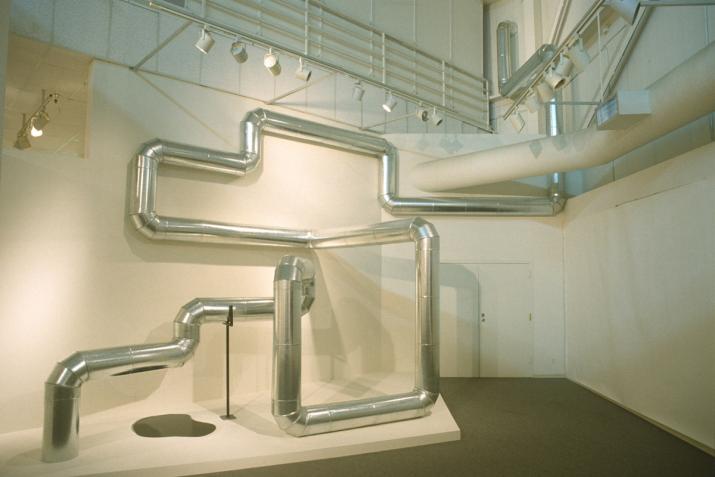
Systems: A Conversation with Nancy Holt

Nancy Holt interviewed by Joan Marter Published in Sculpture Magazine, 2013
Nancy Holt is acclaimed as a filmmaker, photographer, writer, and sculptor whose work spans more than three decades. Her public art commissions include Dark Star Park in Rosslyn, Arlington, Virginia; Catch Basin in St. James Park in Toronto, and the iconic Sun Tunnels in Great Desert Basin, Utah. Holt’s “systems” access the great infrastructure of the earth and act as environmental projects that join the viewer to the wonders of the solar system. Her work with systems has produced major sculptural innovations, including installations that extend from interior galleries to exterior spaces. In addition, time-based elements stimulate participation in her work, whether viewers turn down the heat in an art gallery, feel a gust of air, experience the summer solstice, or trace light from the constellations overhead.
Born in Worcester, Massachusetts, in 1938, Holt grew up in New Jersey and graduated from Tufts University, where she majored in biology. In 1963, she and Robert Smithson (1938-1973) married. Beginning in the early 1970’s she made a series of ambitious sculpture projects in remote locations. Sun Tunnels, constructed in the desert, brings the stars down from the sky to register within gigantic tunnels and frames the sun on the horizon during the seasonal solstices.
Many of Holt’s early outdoor projects survive. They are joined by more recent installations such as Solar Rotary in Tampa, Florida, a fascinating ensemble that incorporates a meteorite into complex shadow patterns responding to the summer solstice and other specific dates. Nancy Holt: Sightlines, a book published in conjunction with her recent traveling retrospective, gathers her diverse body of work together for the first time.
Joan Marter: Your site-specific, system pieces are very important, and you’ve written eloquently about some of them. I have one of your quotes: “[My] sculptures are exposed fragments of vast hidden networks. They are part of open-ended systems, part of the world.” Could you comment on this idea in terms of your body of work as a whole?
Nancy Holt: What I often call my system sculptures are not things in themselves that begin and end in the gallery or in the actual outdoor site, but rather they’re a part of a huge network of interconnected conduit systems often deep within the ground or in the walls of buildings. So, natural elements are flowing through these systems, and I build a work that continues the flow and makes it visible and more conscious. In the case of Waterwork, the substance, water, that flows through the system goes out into a drainage system and eventually into the ocean. Initially there’s an evaporation process, with water from the ocean and rain that falls into a reservoir flowing into a vast underground network of pipes—I tap into that network. The water is channeled through my system of pipes and back down into the drainage.
With electricity, the energy is being produced at a generating plant from the plutonium and coal and oil deep within our planet. The title of the first one I did in 1982, Electrical System (for Thomas Edison), also alludes to the name of the New York City generating station, Con Edison. The title turns one’s mind to basic electricity, both in its discovery and in its generation. From deep within the earth, from the transformation of natural substances, energy is being produced, and this energy in the form of electricity goes through buried pipes and steel conduits in building walls. In the case of Electrical System (for Thomas Edison), you could see the electrical box on the wall where the conduit came out, and you were surrounded by electricity. The sculpture also lit the gallery. Like all of these pieces, it was functional—there was no other light except the light produced by the work. The same was true of Hot Water Heat at John Weber Gallery (1984)—it functioned as the heating system for the gallery.

JM: You’ve also spoken about how you want people to become aware of the fact that we are using limited resources.
NH: We often use water and electricity so indiscriminately, we’re just not thinking. You turn on a light switch, and the light is there, but it’s only been there for a little over 100 years. The history of technology is also part of the art I did in the early ’80s, using systems. I was able to use basic systems as art, as elements of art, because they had been there for a long period and had not essentially changed. In doing research I found the technologies for plumbing and electricity are very basic and essentially worked out in the early 20th Century. As an artist, I could bring another consciousness to these technologies. For instance, in Catch Basin, in Toronto, I used inverted terra-cotta channel pipes, which were first used in France hundreds of years ago. Channeling water is very ancient—there are for instance the aqueducts of Greece and Rome; and the sophisticated drainage system of the Neolithic Skara Brae village on Scotland’s Orkney Island. Crop irrigation has been with us from the beginning of civilization. And though with electricity, we’re talking about 100 years rather than thousands of years, the point is that all of these technologies have already reached their apex and are now just in common use with a little technological tweaking now and then. Technic in Greek means art or artifice. Technology and art don’t exclude each other. It’s like using one art form to make another art form.
JM: You’ve also talked about the fact that some of your works, particularly Pipeline, have a very strong political message. Pipeline snakes 30 feet, traverses walls, and goes outdoors and indoors.
NH: Pipeline dripped dark oil into a puddle on the floor, which referred to leaks in the Alaska pipeline. I was invited to Alaska to get inspired by the landscape, and the thing that most overwhelmed me was seeing the pipeline going in and out of the land, traversing the mountains, and spanning lakes, while knowing that they hadn’t perfected the system. The pipe was rusting and subject to freezing, so there were a lot of spills into the pristine environment. In response, I built my own pipeline at the Anchorage Art Museum. Parts of it were outdoors, and one segment arched over a railroad track and then went into the ground and came up and formed an archway that you could walk under when you entered the museum. Then it twisted around the corner and appeared to pierce the building; inside, at the exact same place, a pipe turned a few times and slowly made its way down from the very high ceiling. Eventually, like the Alaska pipeline, it was held by braces, and, just at that point, the oil dripped. It was on a timer, and the oil would drip so many drops per hour into the pool on the floor. The gallery was partially funded by the oil company, so the curators and the director were very courageous to have a work like this.

JM: In the case of Waterwork (1983–84), a participatory fountain of sorts at Gallaudet University in Washington, DC, there was quite a response from a particular audience.
NH: Yes, definitely. Waterwork was located near the University’s elementary school for deaf children, and the young students, far more than the adults, were curious about where the water comes from. The main pipe plunged down and split into two pipes which contained two geometrical areas of sand, where they could turn the water on and use it to make sand forms. This way, they could get a sense of the water’s feel and how things mixed with it, they could think about how water comes to us. They had a sense of wonder. We turn the water on many times every day. How often do we have that sense of wonder?
JM: Waterwork, which was dismantled in 1995, brings up the fact that not all of these pieces are still installed. Catch Basin (1982) in St. James Park remains in operation, though, and still functions.
NH: It does, and not only does it function as art and as a visible way of seeing land drainage, but it also has a purposeful aspect. By tearing down old buildings the park had just been expanded and regraded and planted with grass. After a few rains however a sunken area developed where water collected, which is unsafe. Standing water breeds insects, algae, and microbes. I told them that I’d build a sculpture that would fix the problem for them. Catch Basin drains the water in that area of the park. It’s art that’s also functional.
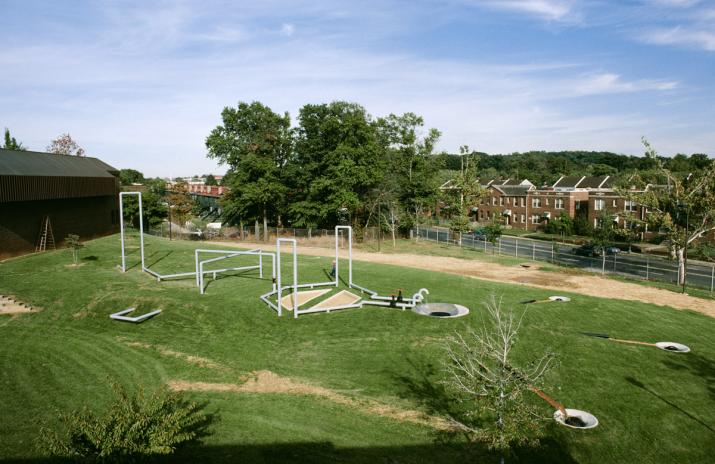
JM: Functionality has played a consistent role in your work. You mentioned the electrical piece at John Weber Gallery, where you also created Hot Water Heat (1984). That work functioned as the hot water heating system. Visitors could rotate the wheel in order to turn off the flow of hot water.
NH: For the time that it was up, yes Hot Water Heat was the heating system of the gallery and the main valve wheel could be turned on and off. The gallery staff was there and could check on it. Waterwork had a timer—the water could only be turned on and off at certain times of the day. You couldn’t leave it on constantly. I like that potential participatory involvement; I think it increases the sensation of the elements flowing through the work.
JM: You’ve referred to being “physically and visually connected by a single pipe to water coming in from the vast urban infrastructure.” Basically, these works provide situations in which people become concretely aware of that connection.
NH: Yes, and it never ceases to amaze me that you can actually have an effect on the flow of water or air and with electrical systems, all you have to do is flip the switch to turn the whole thing off. There is lurking participatory potential.
JM: I’m also interested in the two ventilation pieces that you did, one at Guild Hall in East Hampton and the other in the Tampere Art Museum in Finland. The one in Finland actually circulated air, from the outside in and the inside out.
NH: The Guild Hall piece strongly evoked the inside/outside connection but the wall was not penetrated. In Finland, the work brought some air into the museum, so that there was interchange of air between the outdoors and the indoors via the ventilators. I did a total of four ventilation pieces, the first one in 1985 at the Temple Gallery in Philadelphia.
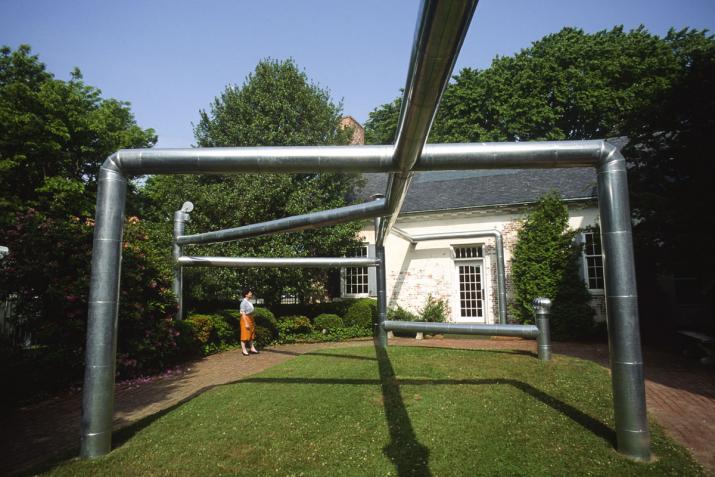
JM: In speaking about these pieces in particular, you’ve mentioned a playful quality that I think characterizes a number of your systems pieces. We could even use the word “absurd,” taken from Eva Hesse’s notion of the absurd in art.
NH: Yes, I think that’s definitely part of this work, and I felt a connection with Eva Hesse’s work. She and I had often talked of the absurdity factor in her art. There’s a sense of absurdity and of taking things to extremes, like bending pipes in unusual ways and twisting them around on themselves. Gauges within the system show you the water flowing through, so that it isn’t just about seeing pipes—you’re actually seeing the water flow, every time you see a wheel turn within the system. Hot Water Heat had a mechanism on the wall where I put circular graph paper. During the day, a red pen and a blue pen drew the temperature and the humidity. So, the sculpture produced its own drawings, which I thought was an interesting idea. There were pressure gauges that you could watch to see the pressure go up and down and water wheels spun with the flow, and there were radiators, strange-looking, old-fashioned radiators that emanated heat, so there was a playfulness as well.
JM: But on a human scale: all of these systems projects are done so that they relate to the human.
NH: Yes, absolutely. I’m interested in bringing the universe to the human being. There is a strong connection between Sun Tunnels and these systems pieces because Sun Tunnels is part of a system as well, the solar system. The work is just an element within a much vaster system in which the sun rises and sets on the solstices. During the day, the sun casts light through the holes in some of the tunnels and creates ever-changing spots of light. You can walk through the tunnels, and these spots of light are like the stars; the sun being a star, it’s casting its starlight at your feet. So, the tunnels really are indicators of much vaster systems, just like the system pieces are part of a whole, part of a huge, manmade system through which we channel elements.
JM: You talk about the systems works as site-specific to a gallery. Could they be re-created in a museum space, for example?
NH: Well, they could, and I had that in mind when I did them. It’s easier now than then for museums to re-create rooms, but it’s hard for people to believe that these works could be made again—though I just did it for The Light Show at the Hayward Art Gallery in London, and it was thrilling for me to see Holes of Light again just as it was in 1973. They re-created the room at the LoGuidice Gallery in New York where I had initially done Holes of Light. Remaking this installation proves the point that museums could own these works, but in the past they thought of it as being difficult to do or they couldn’t imagine it. But now work by artists from Sol LeWitt to Sarah Sze can be exhibited time and time again with plans, photographs and caring assistants.
JM: Electrical System, from John Weber Gallery, could be created in a museum space of the right scale. It would work very well, in fact.
NH: It wouldn’t be that hard to do. It’s standard electric conduit and there are special tools that bend it. In the early 1980’s artists would often learn a skill, like electrical work or plumbing to get by financially, I usually worked with these artist electricians and plumbers. They understood that I was trying to make a work of art. It was all done to code. We did it exactly the way you would do any functional electrical or plumbing system.
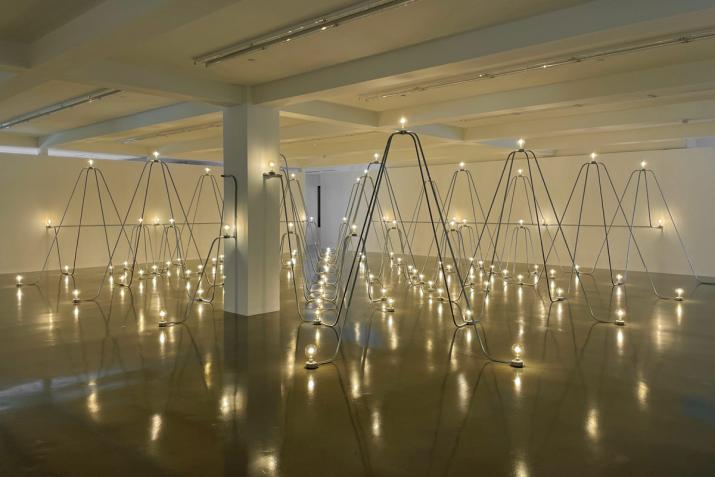
JM: A recent Whitney program on women and technology made the point that collaboration is necessary for these types of projects. You have always collaborated, with astrophysicists and engineers, among other experts. I am especially thinking of the collaboration behind Dark Star Park.
NH: Many different people from various areas of expertise worked on Dark Star Park. Sometimes I am coordinating a hundred or more people on my large scale projects. Advances in technology allowed me to do a lot of things that I desired. For instance, the slopes could be steeper because we used soil fabric, which was quite new at the time. As we put the earth on the mound, the fabric would hold it in place. There was also the process of making gunite concrete spheres with revolving templates.
JM: I was always impressed with the fact that you were brought on to the park project before the architect of the building; you sat on the selection committee that approved the architecture.
NH: The first building design scheme tried to use the park as a front yard. The integrity of the park/artwork as standing its own ground was at stake. And the architect was being insensitive to where most people were going to enter the building which was from the side; I held sway with my park concerns and our committee rejected the design, and asked for a second design which was finally accepted.
JM: Eventually you had the park extend right under the eaves of the building.
NH: Yes, I was able to convince the developer to do that. It also allowed the patio to curve out into the park somewhat so people can sit, eat and drink and look out over the park.

JM: I must say, having visited Dark Star Park when you were just completing it and having returned recently, it’s very verdant these days.
NH: Yes, it’s very verdant. I selected the plants and trees that are part of Dark Star Park. The entire park with its mounds, spheres, pools, tunnels, plants is an artwork. Before and after pictures show what it looked like when we first planted the trees and now, when they’ve grown into mature, overarching trees.
JM: It’s a very beautiful spot, even though it’s just a little pocket of land. The area is less than an acre, and yet you’ve created a wonderful oasis in the midst of all these concrete structures.
NH: You know what amazes me? When the work was finished, people started saying Dark Star Day for the day when the sun casts shadows of the spheres and poles in alignment with the permanent shadow patterns in the ground. It happens at approximately 9:32 a.m. on August 1, and annually if it is sunny people go and watch the shadows align. In 2009, when we celebrated the park’s 25th anniversary, Arlington County made it an official day.
It’s very interesting that once the works exist, people go to them on a yearly basis. This is totally independent of me; it’s something that happens on its own. People go to see the solstice at Sun Tunnels or Annual Ring or Solar Rotary—I have quite a few works with a solstice aspect, casting shadows, aligning, or directing light through a circle overhead. Sometimes I check my works on the Internet, and I’ll find a local newspaper article covering the fact that people had gathered, once with a picture of everyone holding hands in the middle of the sculpture. It’s a phenomenon. It’s awesome to me that the works are a nexus for people.
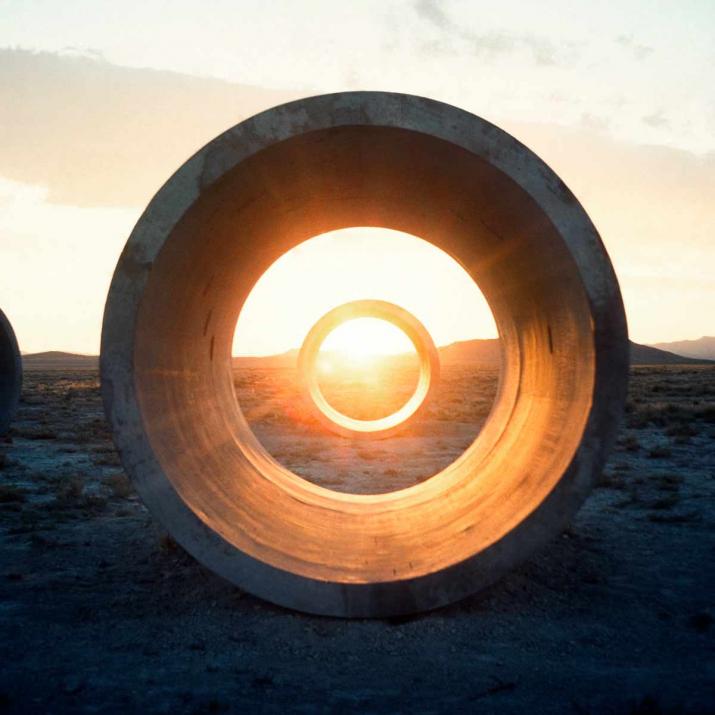
JM: Dark Star Park also commemorates a specific date in the history of Rosslyn, when the land of the town was bought. To translate that into marks on the ground that line up on that day in terms of the placement of the sun is a significant, and unique, feat. People engage the work repeatedly over time because of the temporal elements, whether the seasonal cycles of nature or dates in human history.
NH: Solar Rotary, at the University of South Florida in Tampa, has six elements that line up. There is the summer solstice, and then there are the five plaques commemorating points of Florida’s history over the centuries. One of them marks Ponce de Leon’s first reported sighting of Florida by an inhabitant of another continent in 1513; another plaque marks the British governor being presented with the first map of the coast of Florida in 1772. There are also the dates for the founding of the university and the Apollo 11 moon shot, which launched from Florida. Then, right in the center of the sculpture there is a 4.5-billion-year-old meteorite, which fell to earth in Florida—it’s the oldest thing you’ll ever touch. People are drawn to it. Can you imagine touching something that old from the beginning of the universe, something that dropped out of the sky and ended up in the middle of my sculpture? To me, it’s still amazing.